Investigative Project: Preparation of Phenyl Benzoate and Literature
VerifiedAdded on 2023/03/31
|20
|4192
|134
Project
AI Summary
This project focuses on the preparation of phenyl benzoate, an ester compound, through various methods. It begins with an introduction to phenyl benzoate, its properties, and its uses in industries such as clothing and organic chemistry. The project outlines the objectives, including determining the most efficient preparation method and investigating the physical and chemical properties of the compound. A hypothesis is presented, suggesting that different preparation methods yield varying product quantities due to the equilibrium nature of esterification reactions. The literature review covers esterification processes, equilibrium reactions, and methods to enhance ester yield, such as azeotropic distillation and the use of catalysts. The methodology section details a procedure for preparing phenyl benzoate using phenol, sodium hydroxide, and benzoyl chloride. This document is available on Desklib, which provides a platform for students to access various study tools and solved assignments.

TITLE: PREPARATION OF PHENYL BENZOATE
Paraphrase This Document
Need a fresh take? Get an instant paraphrase of this document with our AI Paraphraser
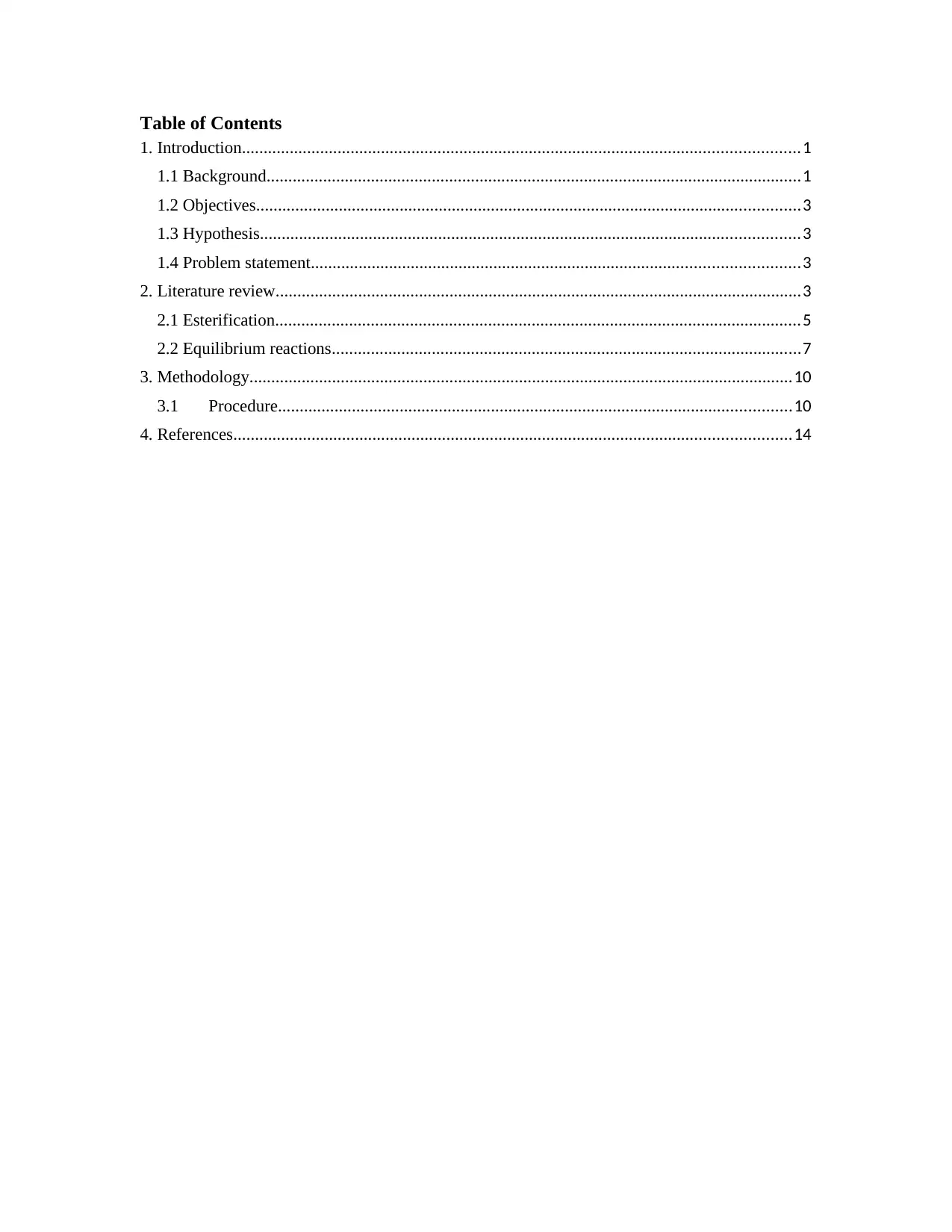
Table of Contents
1. Introduction................................................................................................................................1
1.1 Background...........................................................................................................................1
1.2 Objectives.............................................................................................................................3
1.3 Hypothesis............................................................................................................................3
1.4 Problem statement................................................................................................................3
2. Literature review.........................................................................................................................3
2.1 Esterification.........................................................................................................................5
2.2 Equilibrium reactions............................................................................................................7
3. Methodology.............................................................................................................................10
3.1 Procedure......................................................................................................................10
4. References................................................................................................................................14
1. Introduction................................................................................................................................1
1.1 Background...........................................................................................................................1
1.2 Objectives.............................................................................................................................3
1.3 Hypothesis............................................................................................................................3
1.4 Problem statement................................................................................................................3
2. Literature review.........................................................................................................................3
2.1 Esterification.........................................................................................................................5
2.2 Equilibrium reactions............................................................................................................7
3. Methodology.............................................................................................................................10
3.1 Procedure......................................................................................................................10
4. References................................................................................................................................14
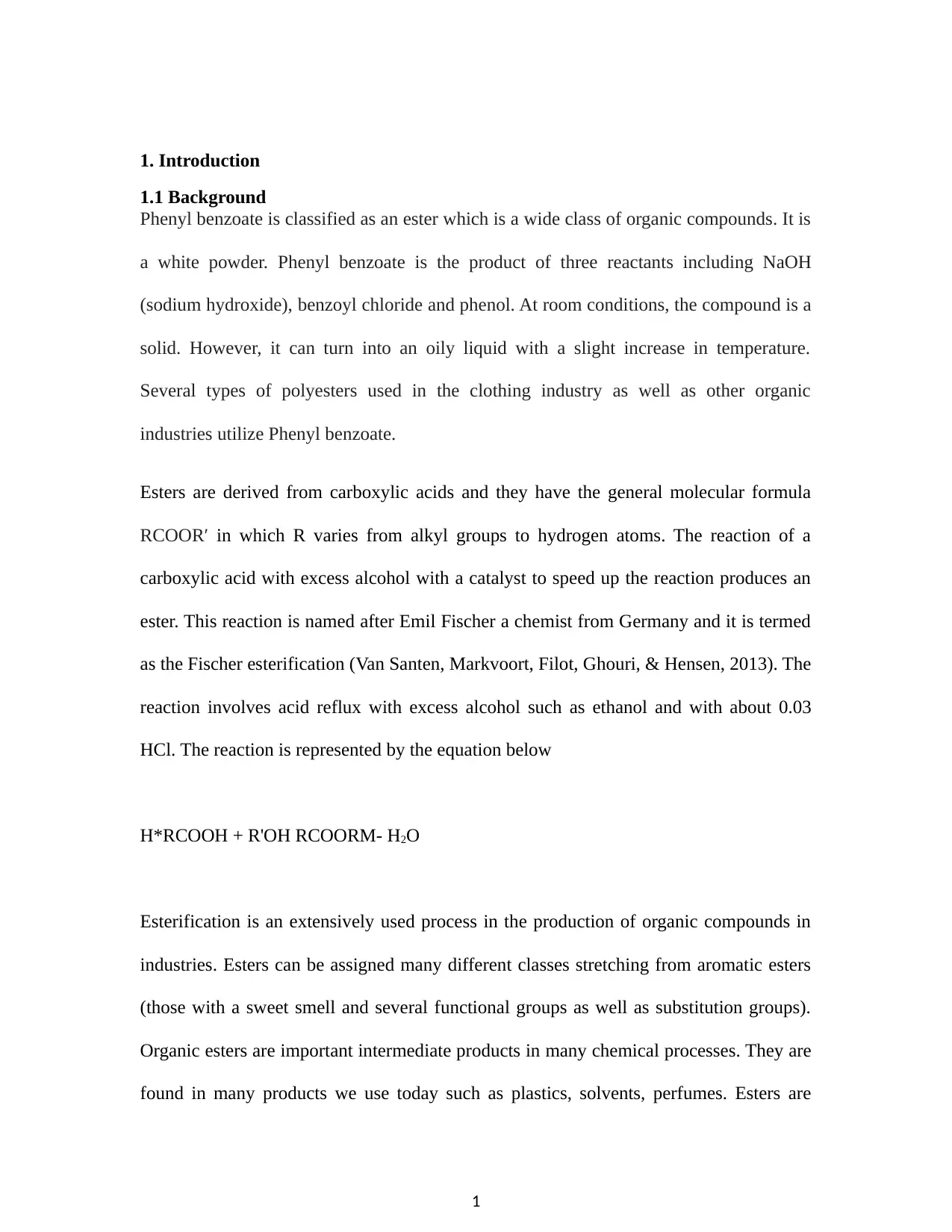
1. Introduction
1.1 Background
Phenyl benzoate is classified as an ester which is a wide class of organic compounds. It is
a white powder. Phenyl benzoate is the product of three reactants including NaOH
(sodium hydroxide), benzoyl chloride and phenol. At room conditions, the compound is a
solid. However, it can turn into an oily liquid with a slight increase in temperature.
Several types of polyesters used in the clothing industry as well as other organic
industries utilize Phenyl benzoate.
Esters are derived from carboxylic acids and they have the general molecular formula
RCOOR′ in which R varies from alkyl groups to hydrogen atoms. The reaction of a
carboxylic acid with excess alcohol with a catalyst to speed up the reaction produces an
ester. This reaction is named after Emil Fischer a chemist from Germany and it is termed
as the Fischer esterification (Van Santen, Markvoort, Filot, Ghouri, & Hensen, 2013). The
reaction involves acid reflux with excess alcohol such as ethanol and with about 0.03
HCl. The reaction is represented by the equation below
H*RCOOH + R'OH RCOORM- H2O
Esterification is an extensively used process in the production of organic compounds in
industries. Esters can be assigned many different classes stretching from aromatic esters
(those with a sweet smell and several functional groups as well as substitution groups).
Organic esters are important intermediate products in many chemical processes. They are
found in many products we use today such as plastics, solvents, perfumes. Esters are
1
1.1 Background
Phenyl benzoate is classified as an ester which is a wide class of organic compounds. It is
a white powder. Phenyl benzoate is the product of three reactants including NaOH
(sodium hydroxide), benzoyl chloride and phenol. At room conditions, the compound is a
solid. However, it can turn into an oily liquid with a slight increase in temperature.
Several types of polyesters used in the clothing industry as well as other organic
industries utilize Phenyl benzoate.
Esters are derived from carboxylic acids and they have the general molecular formula
RCOOR′ in which R varies from alkyl groups to hydrogen atoms. The reaction of a
carboxylic acid with excess alcohol with a catalyst to speed up the reaction produces an
ester. This reaction is named after Emil Fischer a chemist from Germany and it is termed
as the Fischer esterification (Van Santen, Markvoort, Filot, Ghouri, & Hensen, 2013). The
reaction involves acid reflux with excess alcohol such as ethanol and with about 0.03
HCl. The reaction is represented by the equation below
H*RCOOH + R'OH RCOORM- H2O
Esterification is an extensively used process in the production of organic compounds in
industries. Esters can be assigned many different classes stretching from aromatic esters
(those with a sweet smell and several functional groups as well as substitution groups).
Organic esters are important intermediate products in many chemical processes. They are
found in many products we use today such as plastics, solvents, perfumes. Esters are
1
⊘ This is a preview!⊘
Do you want full access?
Subscribe today to unlock all pages.

Trusted by 1+ million students worldwide
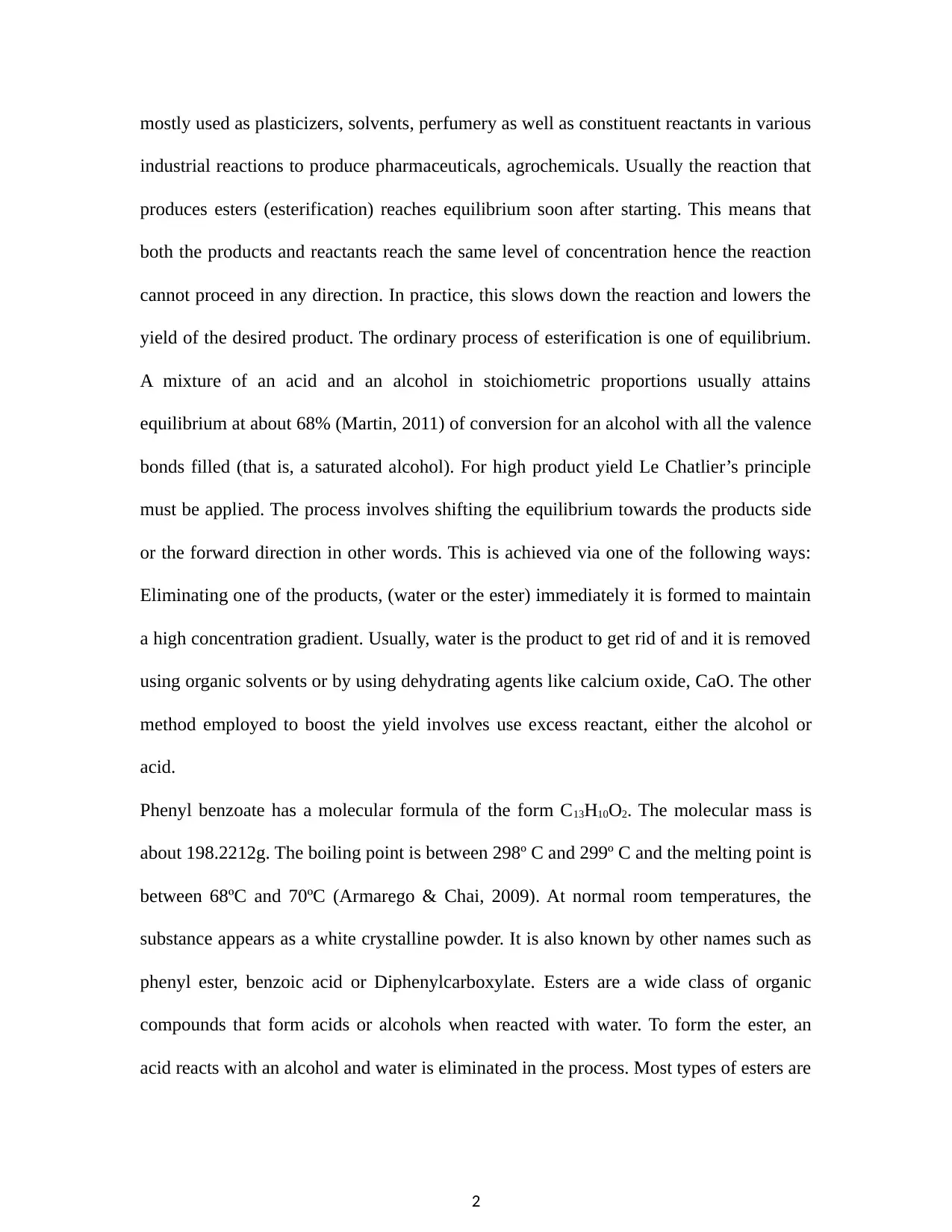
mostly used as plasticizers, solvents, perfumery as well as constituent reactants in various
industrial reactions to produce pharmaceuticals, agrochemicals. Usually the reaction that
produces esters (esterification) reaches equilibrium soon after starting. This means that
both the products and reactants reach the same level of concentration hence the reaction
cannot proceed in any direction. In practice, this slows down the reaction and lowers the
yield of the desired product. The ordinary process of esterification is one of equilibrium.
A mixture of an acid and an alcohol in stoichiometric proportions usually attains
equilibrium at about 68% (Martin, 2011) of conversion for an alcohol with all the valence
bonds filled (that is, a saturated alcohol). For high product yield Le Chatlier’s principle
must be applied. The process involves shifting the equilibrium towards the products side
or the forward direction in other words. This is achieved via one of the following ways:
Eliminating one of the products, (water or the ester) immediately it is formed to maintain
a high concentration gradient. Usually, water is the product to get rid of and it is removed
using organic solvents or by using dehydrating agents like calcium oxide, CaO. The other
method employed to boost the yield involves use excess reactant, either the alcohol or
acid.
Phenyl benzoate has a molecular formula of the form C13H10O2. The molecular mass is
about 198.2212g. The boiling point is between 298º C and 299º C and the melting point is
between 68ºC and 70ºC (Armarego & Chai, 2009). At normal room temperatures, the
substance appears as a white crystalline powder. It is also known by other names such as
phenyl ester, benzoic acid or Diphenylcarboxylate. Esters are a wide class of organic
compounds that form acids or alcohols when reacted with water. To form the ester, an
acid reacts with an alcohol and water is eliminated in the process. Most types of esters are
2
industrial reactions to produce pharmaceuticals, agrochemicals. Usually the reaction that
produces esters (esterification) reaches equilibrium soon after starting. This means that
both the products and reactants reach the same level of concentration hence the reaction
cannot proceed in any direction. In practice, this slows down the reaction and lowers the
yield of the desired product. The ordinary process of esterification is one of equilibrium.
A mixture of an acid and an alcohol in stoichiometric proportions usually attains
equilibrium at about 68% (Martin, 2011) of conversion for an alcohol with all the valence
bonds filled (that is, a saturated alcohol). For high product yield Le Chatlier’s principle
must be applied. The process involves shifting the equilibrium towards the products side
or the forward direction in other words. This is achieved via one of the following ways:
Eliminating one of the products, (water or the ester) immediately it is formed to maintain
a high concentration gradient. Usually, water is the product to get rid of and it is removed
using organic solvents or by using dehydrating agents like calcium oxide, CaO. The other
method employed to boost the yield involves use excess reactant, either the alcohol or
acid.
Phenyl benzoate has a molecular formula of the form C13H10O2. The molecular mass is
about 198.2212g. The boiling point is between 298º C and 299º C and the melting point is
between 68ºC and 70ºC (Armarego & Chai, 2009). At normal room temperatures, the
substance appears as a white crystalline powder. It is also known by other names such as
phenyl ester, benzoic acid or Diphenylcarboxylate. Esters are a wide class of organic
compounds that form acids or alcohols when reacted with water. To form the ester, an
acid reacts with an alcohol and water is eliminated in the process. Most types of esters are
2
Paraphrase This Document
Need a fresh take? Get an instant paraphrase of this document with our AI Paraphraser
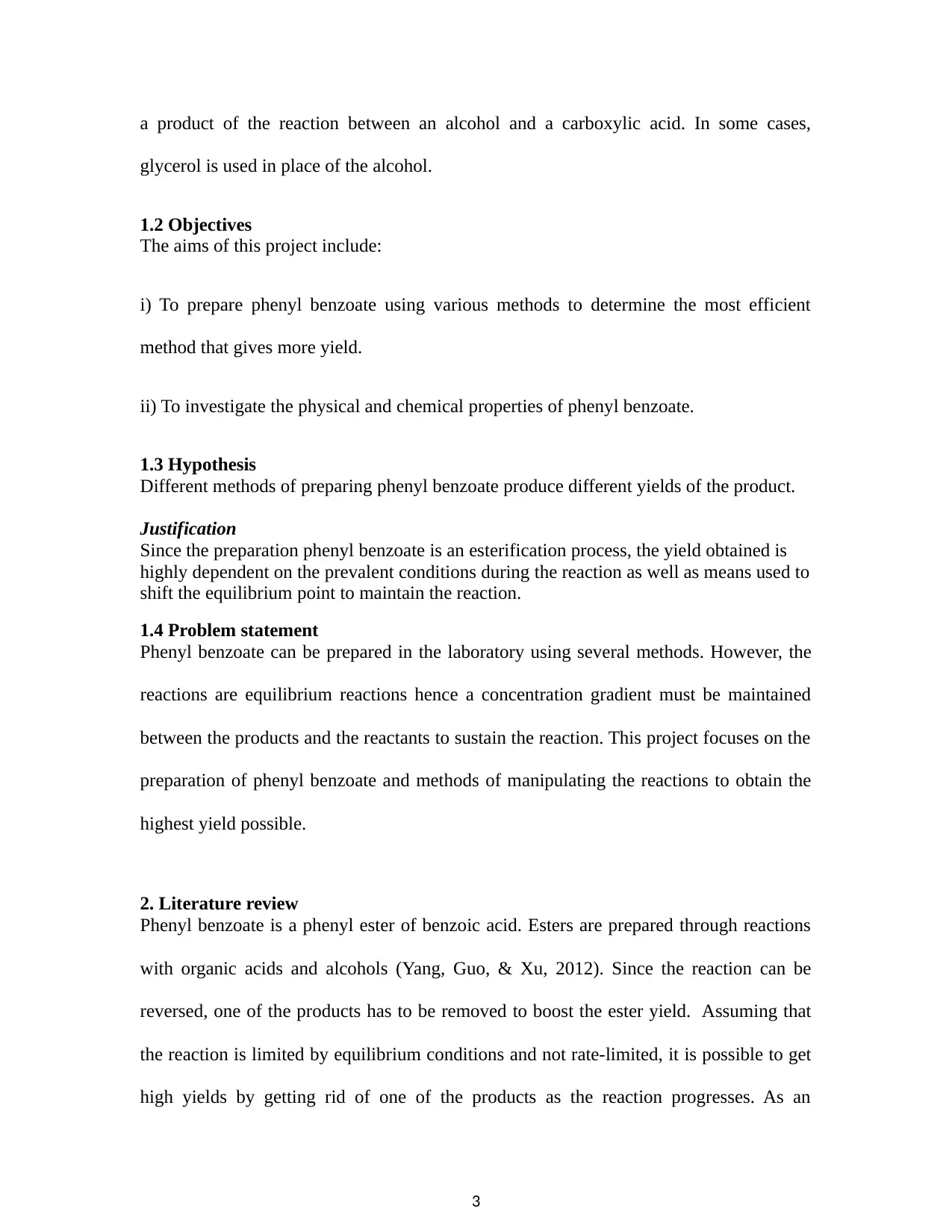
a product of the reaction between an alcohol and a carboxylic acid. In some cases,
glycerol is used in place of the alcohol.
1.2 Objectives
The aims of this project include:
i) To prepare phenyl benzoate using various methods to determine the most efficient
method that gives more yield.
ii) To investigate the physical and chemical properties of phenyl benzoate.
1.3 Hypothesis
Different methods of preparing phenyl benzoate produce different yields of the product.
Justification
Since the preparation phenyl benzoate is an esterification process, the yield obtained is
highly dependent on the prevalent conditions during the reaction as well as means used to
shift the equilibrium point to maintain the reaction.
1.4 Problem statement
Phenyl benzoate can be prepared in the laboratory using several methods. However, the
reactions are equilibrium reactions hence a concentration gradient must be maintained
between the products and the reactants to sustain the reaction. This project focuses on the
preparation of phenyl benzoate and methods of manipulating the reactions to obtain the
highest yield possible.
2. Literature review
Phenyl benzoate is a phenyl ester of benzoic acid. Esters are prepared through reactions
with organic acids and alcohols (Yang, Guo, & Xu, 2012). Since the reaction can be
reversed, one of the products has to be removed to boost the ester yield. Assuming that
the reaction is limited by equilibrium conditions and not rate-limited, it is possible to get
high yields by getting rid of one of the products as the reaction progresses. As an
3
glycerol is used in place of the alcohol.
1.2 Objectives
The aims of this project include:
i) To prepare phenyl benzoate using various methods to determine the most efficient
method that gives more yield.
ii) To investigate the physical and chemical properties of phenyl benzoate.
1.3 Hypothesis
Different methods of preparing phenyl benzoate produce different yields of the product.
Justification
Since the preparation phenyl benzoate is an esterification process, the yield obtained is
highly dependent on the prevalent conditions during the reaction as well as means used to
shift the equilibrium point to maintain the reaction.
1.4 Problem statement
Phenyl benzoate can be prepared in the laboratory using several methods. However, the
reactions are equilibrium reactions hence a concentration gradient must be maintained
between the products and the reactants to sustain the reaction. This project focuses on the
preparation of phenyl benzoate and methods of manipulating the reactions to obtain the
highest yield possible.
2. Literature review
Phenyl benzoate is a phenyl ester of benzoic acid. Esters are prepared through reactions
with organic acids and alcohols (Yang, Guo, & Xu, 2012). Since the reaction can be
reversed, one of the products has to be removed to boost the ester yield. Assuming that
the reaction is limited by equilibrium conditions and not rate-limited, it is possible to get
high yields by getting rid of one of the products as the reaction progresses. As an
3
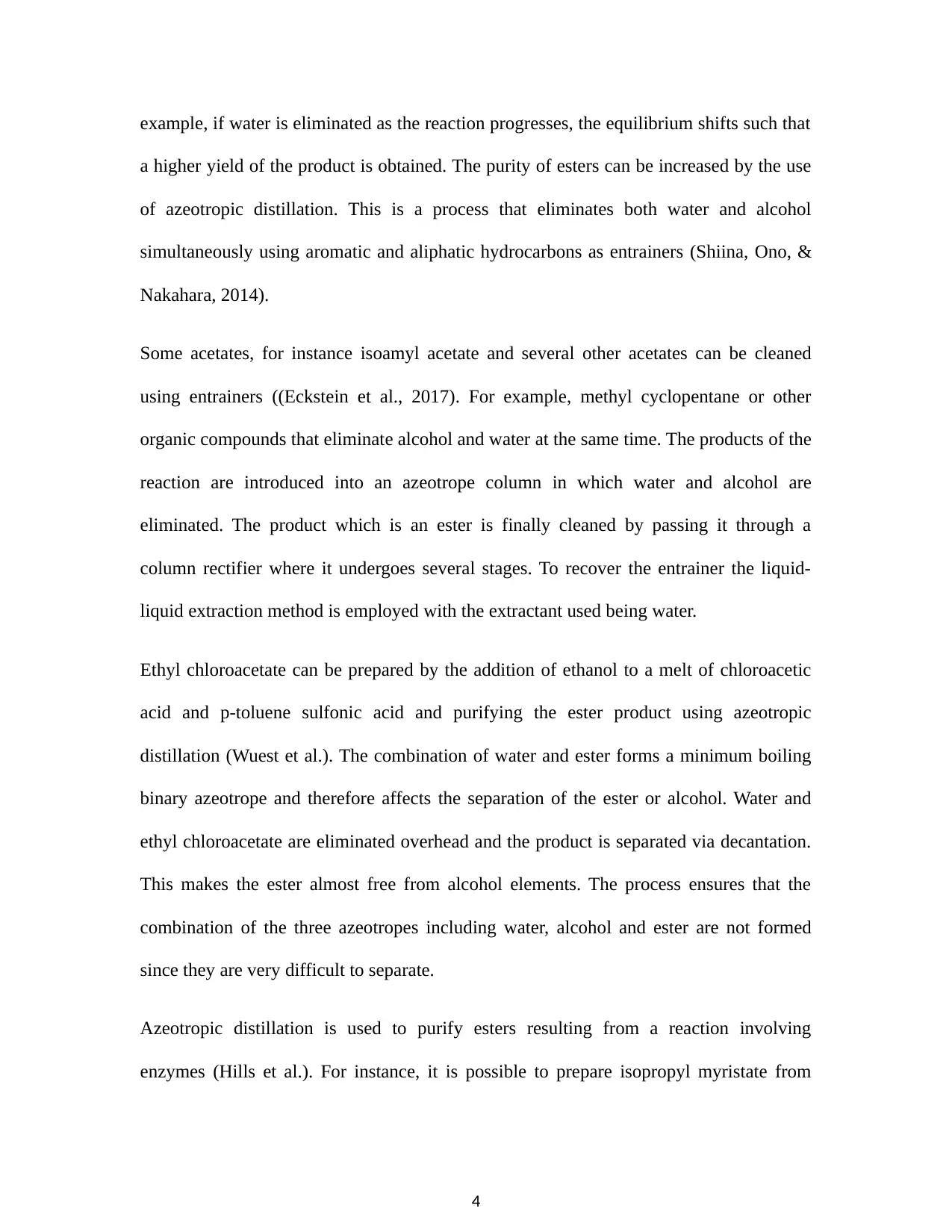
example, if water is eliminated as the reaction progresses, the equilibrium shifts such that
a higher yield of the product is obtained. The purity of esters can be increased by the use
of azeotropic distillation. This is a process that eliminates both water and alcohol
simultaneously using aromatic and aliphatic hydrocarbons as entrainers (Shiina, Ono, &
Nakahara, 2014).
Some acetates, for instance isoamyl acetate and several other acetates can be cleaned
using entrainers ((Eckstein et al., 2017). For example, methyl cyclopentane or other
organic compounds that eliminate alcohol and water at the same time. The products of the
reaction are introduced into an azeotrope column in which water and alcohol are
eliminated. The product which is an ester is finally cleaned by passing it through a
column rectifier where it undergoes several stages. To recover the entrainer the liquid-
liquid extraction method is employed with the extractant used being water.
Ethyl chloroacetate can be prepared by the addition of ethanol to a melt of chloroacetic
acid and p-toluene sulfonic acid and purifying the ester product using azeotropic
distillation (Wuest et al.). The combination of water and ester forms a minimum boiling
binary azeotrope and therefore affects the separation of the ester or alcohol. Water and
ethyl chloroacetate are eliminated overhead and the product is separated via decantation.
This makes the ester almost free from alcohol elements. The process ensures that the
combination of the three azeotropes including water, alcohol and ester are not formed
since they are very difficult to separate.
Azeotropic distillation is used to purify esters resulting from a reaction involving
enzymes (Hills et al.). For instance, it is possible to prepare isopropyl myristate from
4
a higher yield of the product is obtained. The purity of esters can be increased by the use
of azeotropic distillation. This is a process that eliminates both water and alcohol
simultaneously using aromatic and aliphatic hydrocarbons as entrainers (Shiina, Ono, &
Nakahara, 2014).
Some acetates, for instance isoamyl acetate and several other acetates can be cleaned
using entrainers ((Eckstein et al., 2017). For example, methyl cyclopentane or other
organic compounds that eliminate alcohol and water at the same time. The products of the
reaction are introduced into an azeotrope column in which water and alcohol are
eliminated. The product which is an ester is finally cleaned by passing it through a
column rectifier where it undergoes several stages. To recover the entrainer the liquid-
liquid extraction method is employed with the extractant used being water.
Ethyl chloroacetate can be prepared by the addition of ethanol to a melt of chloroacetic
acid and p-toluene sulfonic acid and purifying the ester product using azeotropic
distillation (Wuest et al.). The combination of water and ester forms a minimum boiling
binary azeotrope and therefore affects the separation of the ester or alcohol. Water and
ethyl chloroacetate are eliminated overhead and the product is separated via decantation.
This makes the ester almost free from alcohol elements. The process ensures that the
combination of the three azeotropes including water, alcohol and ester are not formed
since they are very difficult to separate.
Azeotropic distillation is used to purify esters resulting from a reaction involving
enzymes (Hills et al.). For instance, it is possible to prepare isopropyl myristate from
4
⊘ This is a preview!⊘
Do you want full access?
Subscribe today to unlock all pages.

Trusted by 1+ million students worldwide
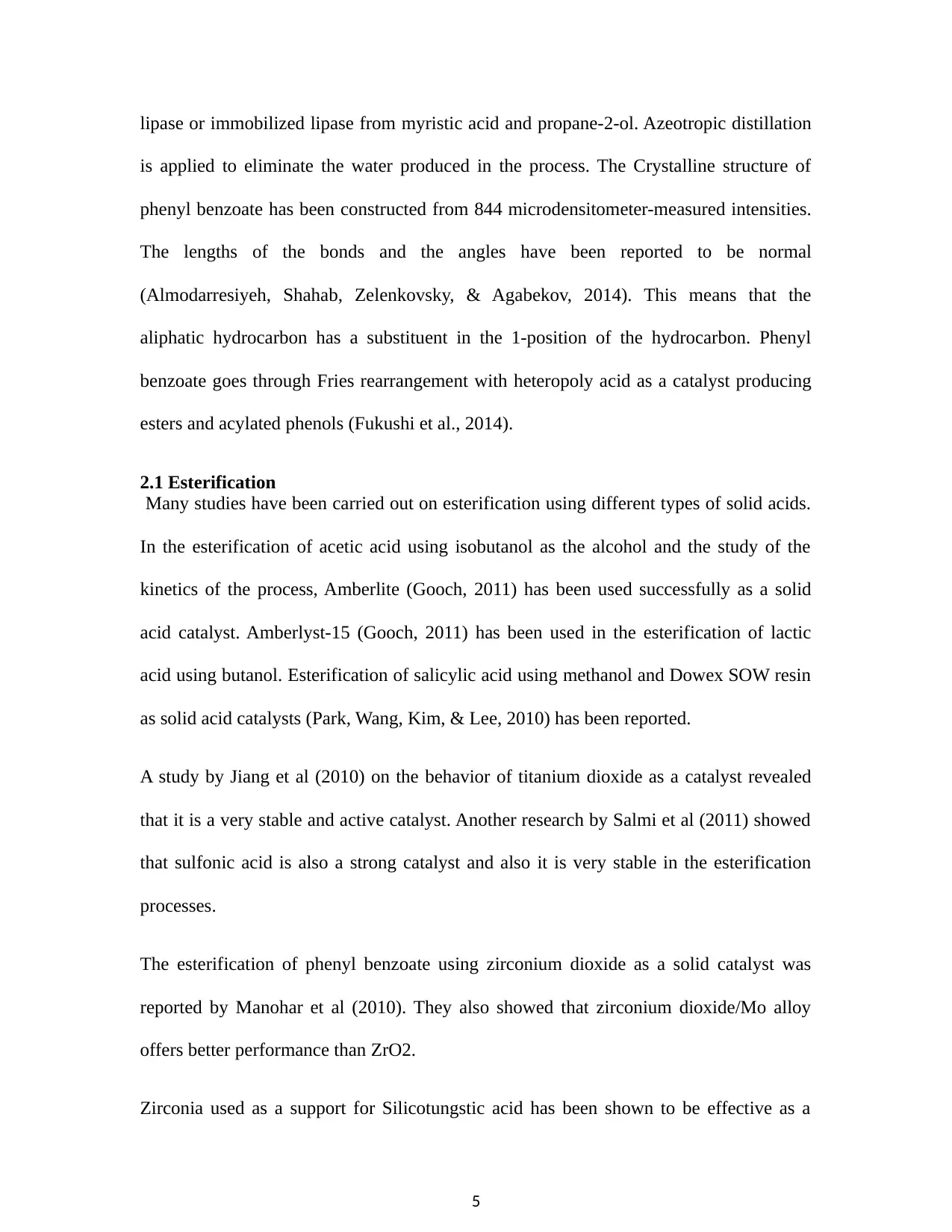
lipase or immobilized lipase from myristic acid and propane-2-ol. Azeotropic distillation
is applied to eliminate the water produced in the process. The Crystalline structure of
phenyl benzoate has been constructed from 844 microdensitometer-measured intensities.
The lengths of the bonds and the angles have been reported to be normal
(Almodarresiyeh, Shahab, Zelenkovsky, & Agabekov, 2014). This means that the
aliphatic hydrocarbon has a substituent in the 1-position of the hydrocarbon. Phenyl
benzoate goes through Fries rearrangement with heteropoly acid as a catalyst producing
esters and acylated phenols (Fukushi et al., 2014).
2.1 Esterification
Many studies have been carried out on esterification using different types of solid acids.
In the esterification of acetic acid using isobutanol as the alcohol and the study of the
kinetics of the process, Amberlite (Gooch, 2011) has been used successfully as a solid
acid catalyst. Amberlyst-15 (Gooch, 2011) has been used in the esterification of lactic
acid using butanol. Esterification of salicylic acid using methanol and Dowex SOW resin
as solid acid catalysts (Park, Wang, Kim, & Lee, 2010) has been reported.
A study by Jiang et al (2010) on the behavior of titanium dioxide as a catalyst revealed
that it is a very stable and active catalyst. Another research by Salmi et al (2011) showed
that sulfonic acid is also a strong catalyst and also it is very stable in the esterification
processes.
The esterification of phenyl benzoate using zirconium dioxide as a solid catalyst was
reported by Manohar et al (2010). They also showed that zirconium dioxide/Mo alloy
offers better performance than ZrO2.
Zirconia used as a support for Silicotungstic acid has been shown to be effective as a
5
is applied to eliminate the water produced in the process. The Crystalline structure of
phenyl benzoate has been constructed from 844 microdensitometer-measured intensities.
The lengths of the bonds and the angles have been reported to be normal
(Almodarresiyeh, Shahab, Zelenkovsky, & Agabekov, 2014). This means that the
aliphatic hydrocarbon has a substituent in the 1-position of the hydrocarbon. Phenyl
benzoate goes through Fries rearrangement with heteropoly acid as a catalyst producing
esters and acylated phenols (Fukushi et al., 2014).
2.1 Esterification
Many studies have been carried out on esterification using different types of solid acids.
In the esterification of acetic acid using isobutanol as the alcohol and the study of the
kinetics of the process, Amberlite (Gooch, 2011) has been used successfully as a solid
acid catalyst. Amberlyst-15 (Gooch, 2011) has been used in the esterification of lactic
acid using butanol. Esterification of salicylic acid using methanol and Dowex SOW resin
as solid acid catalysts (Park, Wang, Kim, & Lee, 2010) has been reported.
A study by Jiang et al (2010) on the behavior of titanium dioxide as a catalyst revealed
that it is a very stable and active catalyst. Another research by Salmi et al (2011) showed
that sulfonic acid is also a strong catalyst and also it is very stable in the esterification
processes.
The esterification of phenyl benzoate using zirconium dioxide as a solid catalyst was
reported by Manohar et al (2010). They also showed that zirconium dioxide/Mo alloy
offers better performance than ZrO2.
Zirconia used as a support for Silicotungstic acid has been shown to be effective as a
5
Paraphrase This Document
Need a fresh take? Get an instant paraphrase of this document with our AI Paraphraser
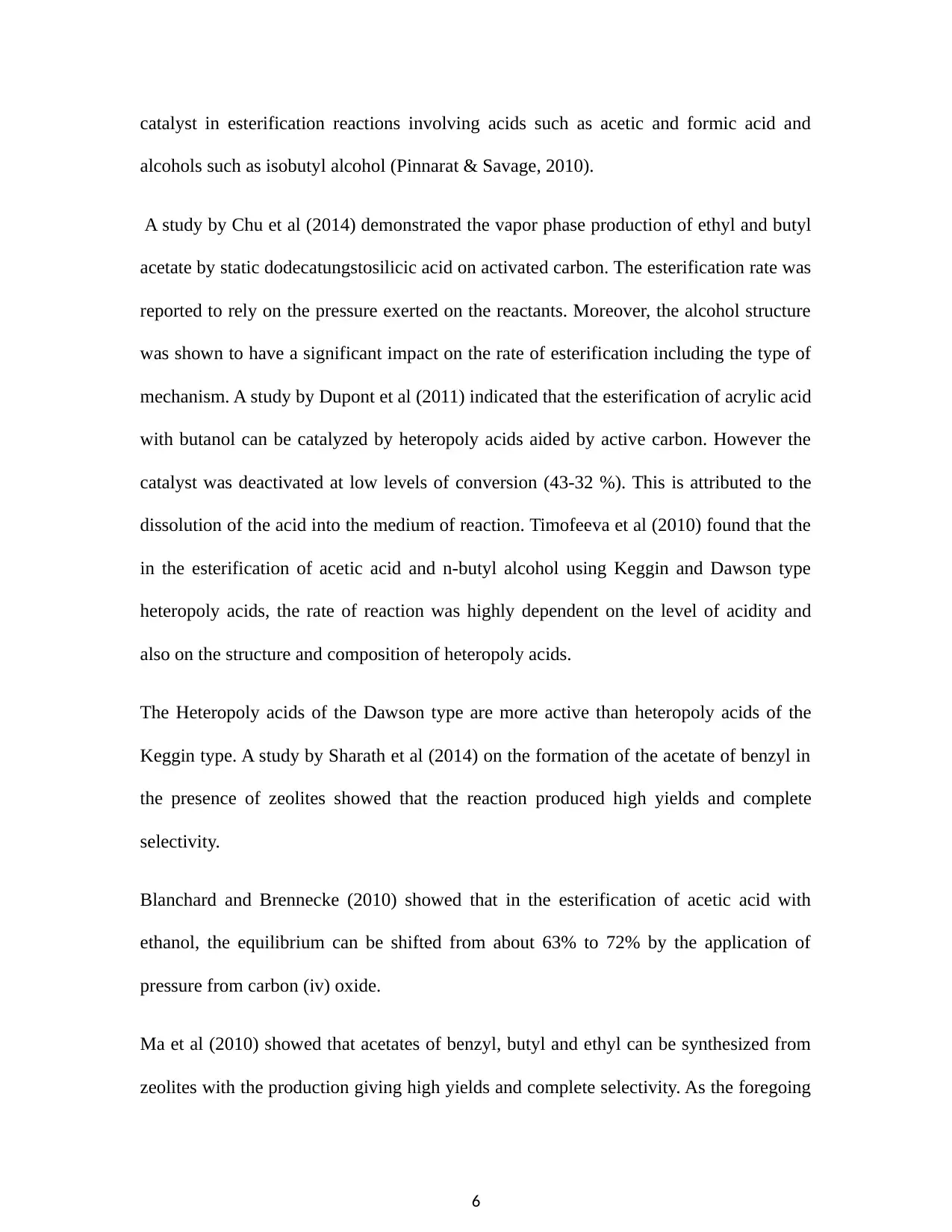
catalyst in esterification reactions involving acids such as acetic and formic acid and
alcohols such as isobutyl alcohol (Pinnarat & Savage, 2010).
A study by Chu et al (2014) demonstrated the vapor phase production of ethyl and butyl
acetate by static dodecatungstosilicic acid on activated carbon. The esterification rate was
reported to rely on the pressure exerted on the reactants. Moreover, the alcohol structure
was shown to have a significant impact on the rate of esterification including the type of
mechanism. A study by Dupont et al (2011) indicated that the esterification of acrylic acid
with butanol can be catalyzed by heteropoly acids aided by active carbon. However the
catalyst was deactivated at low levels of conversion (43-32 %). This is attributed to the
dissolution of the acid into the medium of reaction. Timofeeva et al (2010) found that the
in the esterification of acetic acid and n-butyl alcohol using Keggin and Dawson type
heteropoly acids, the rate of reaction was highly dependent on the level of acidity and
also on the structure and composition of heteropoly acids.
The Heteropoly acids of the Dawson type are more active than heteropoly acids of the
Keggin type. A study by Sharath et al (2014) on the formation of the acetate of benzyl in
the presence of zeolites showed that the reaction produced high yields and complete
selectivity.
Blanchard and Brennecke (2010) showed that in the esterification of acetic acid with
ethanol, the equilibrium can be shifted from about 63% to 72% by the application of
pressure from carbon (iv) oxide.
Ma et al (2010) showed that acetates of benzyl, butyl and ethyl can be synthesized from
zeolites with the production giving high yields and complete selectivity. As the foregoing
6
alcohols such as isobutyl alcohol (Pinnarat & Savage, 2010).
A study by Chu et al (2014) demonstrated the vapor phase production of ethyl and butyl
acetate by static dodecatungstosilicic acid on activated carbon. The esterification rate was
reported to rely on the pressure exerted on the reactants. Moreover, the alcohol structure
was shown to have a significant impact on the rate of esterification including the type of
mechanism. A study by Dupont et al (2011) indicated that the esterification of acrylic acid
with butanol can be catalyzed by heteropoly acids aided by active carbon. However the
catalyst was deactivated at low levels of conversion (43-32 %). This is attributed to the
dissolution of the acid into the medium of reaction. Timofeeva et al (2010) found that the
in the esterification of acetic acid and n-butyl alcohol using Keggin and Dawson type
heteropoly acids, the rate of reaction was highly dependent on the level of acidity and
also on the structure and composition of heteropoly acids.
The Heteropoly acids of the Dawson type are more active than heteropoly acids of the
Keggin type. A study by Sharath et al (2014) on the formation of the acetate of benzyl in
the presence of zeolites showed that the reaction produced high yields and complete
selectivity.
Blanchard and Brennecke (2010) showed that in the esterification of acetic acid with
ethanol, the equilibrium can be shifted from about 63% to 72% by the application of
pressure from carbon (iv) oxide.
Ma et al (2010) showed that acetates of benzyl, butyl and ethyl can be synthesized from
zeolites with the production giving high yields and complete selectivity. As the foregoing
6
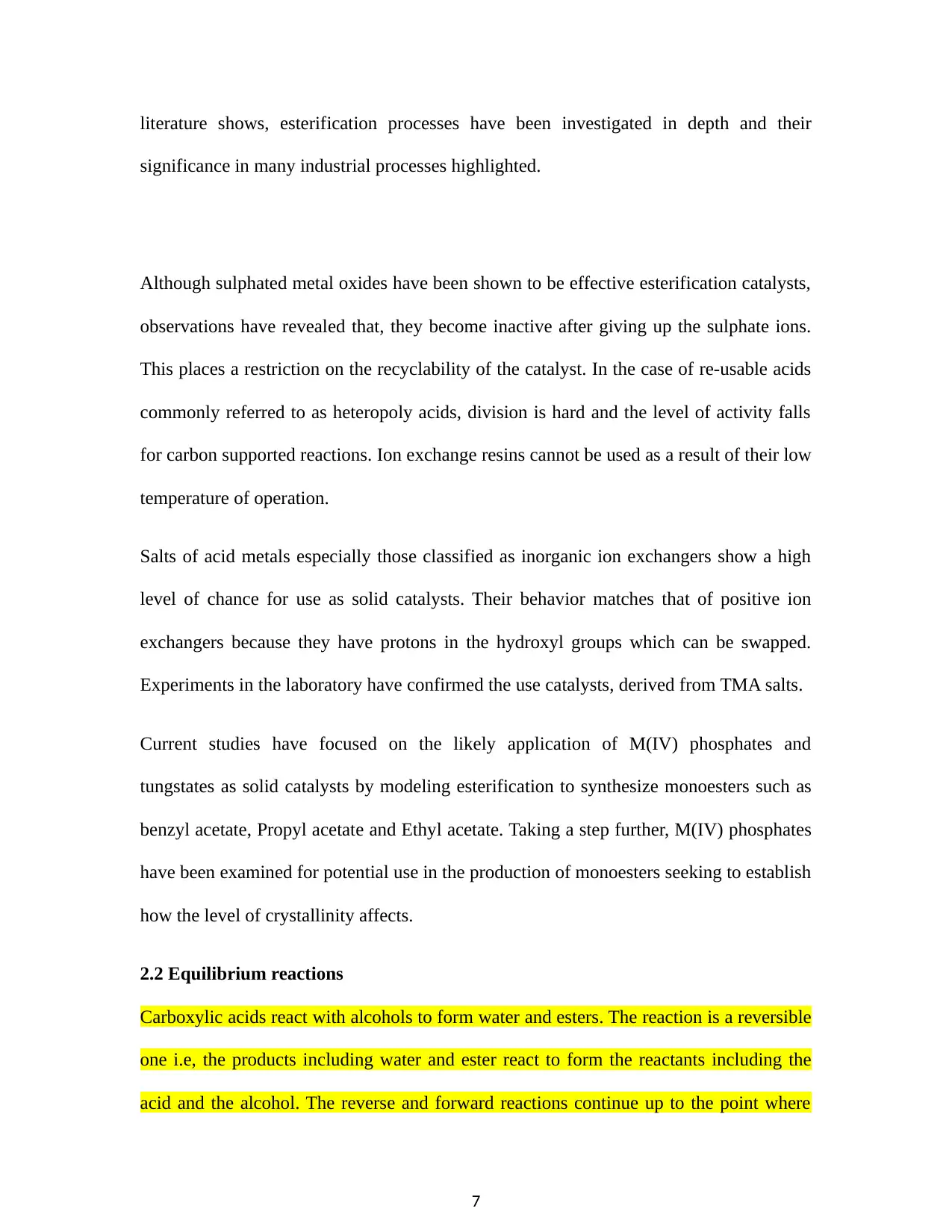
literature shows, esterification processes have been investigated in depth and their
significance in many industrial processes highlighted.
Although sulphated metal oxides have been shown to be effective esterification catalysts,
observations have revealed that, they become inactive after giving up the sulphate ions.
This places a restriction on the recyclability of the catalyst. In the case of re-usable acids
commonly referred to as heteropoly acids, division is hard and the level of activity falls
for carbon supported reactions. Ion exchange resins cannot be used as a result of their low
temperature of operation.
Salts of acid metals especially those classified as inorganic ion exchangers show a high
level of chance for use as solid catalysts. Their behavior matches that of positive ion
exchangers because they have protons in the hydroxyl groups which can be swapped.
Experiments in the laboratory have confirmed the use catalysts, derived from TMA salts.
Current studies have focused on the likely application of M(IV) phosphates and
tungstates as solid catalysts by modeling esterification to synthesize monoesters such as
benzyl acetate, Propyl acetate and Ethyl acetate. Taking a step further, M(IV) phosphates
have been examined for potential use in the production of monoesters seeking to establish
how the level of crystallinity affects.
2.2 Equilibrium reactions
Carboxylic acids react with alcohols to form water and esters. The reaction is a reversible
one i.e, the products including water and ester react to form the reactants including the
acid and the alcohol. The reverse and forward reactions continue up to the point where
7
significance in many industrial processes highlighted.
Although sulphated metal oxides have been shown to be effective esterification catalysts,
observations have revealed that, they become inactive after giving up the sulphate ions.
This places a restriction on the recyclability of the catalyst. In the case of re-usable acids
commonly referred to as heteropoly acids, division is hard and the level of activity falls
for carbon supported reactions. Ion exchange resins cannot be used as a result of their low
temperature of operation.
Salts of acid metals especially those classified as inorganic ion exchangers show a high
level of chance for use as solid catalysts. Their behavior matches that of positive ion
exchangers because they have protons in the hydroxyl groups which can be swapped.
Experiments in the laboratory have confirmed the use catalysts, derived from TMA salts.
Current studies have focused on the likely application of M(IV) phosphates and
tungstates as solid catalysts by modeling esterification to synthesize monoesters such as
benzyl acetate, Propyl acetate and Ethyl acetate. Taking a step further, M(IV) phosphates
have been examined for potential use in the production of monoesters seeking to establish
how the level of crystallinity affects.
2.2 Equilibrium reactions
Carboxylic acids react with alcohols to form water and esters. The reaction is a reversible
one i.e, the products including water and ester react to form the reactants including the
acid and the alcohol. The reverse and forward reactions continue up to the point where
7
⊘ This is a preview!⊘
Do you want full access?
Subscribe today to unlock all pages.

Trusted by 1+ million students worldwide
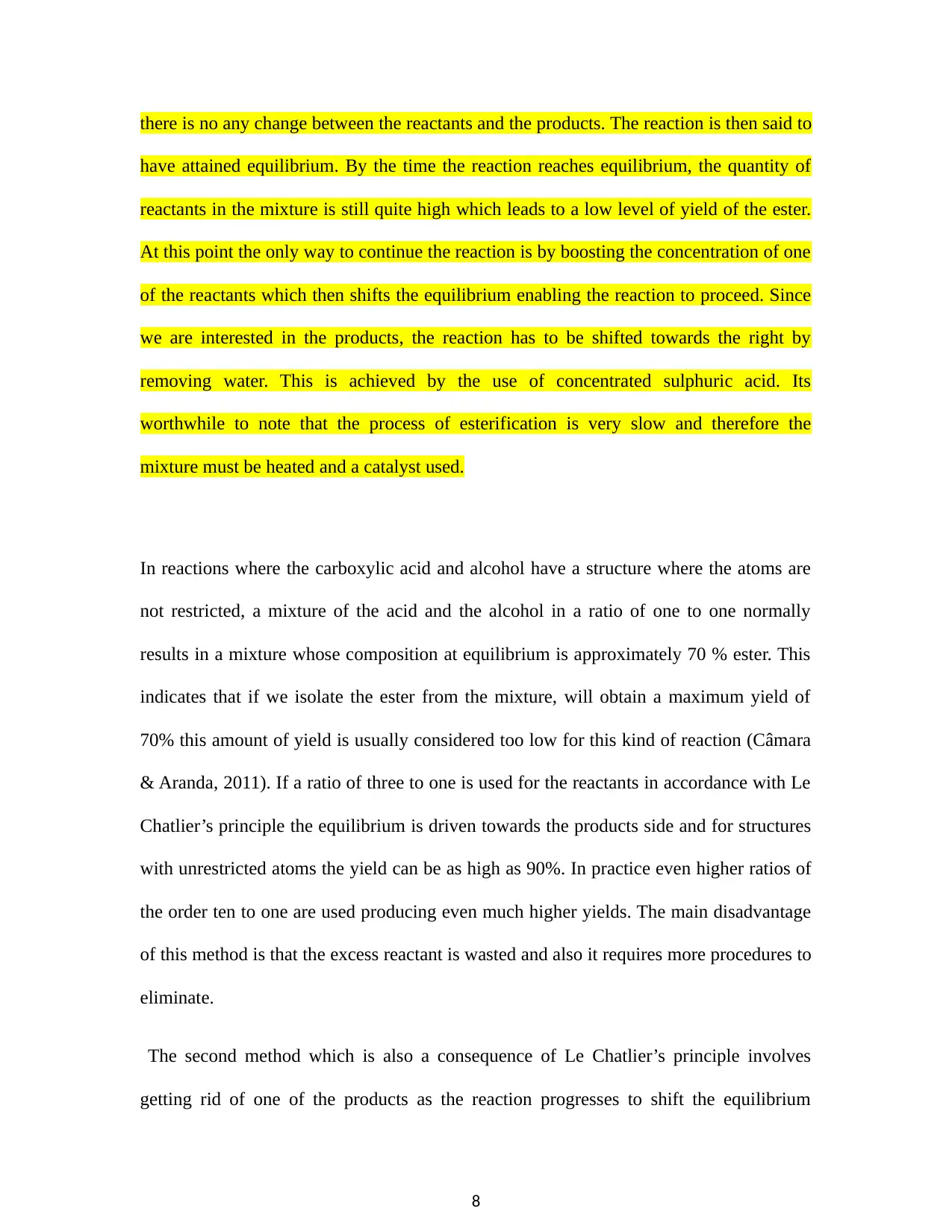
there is no any change between the reactants and the products. The reaction is then said to
have attained equilibrium. By the time the reaction reaches equilibrium, the quantity of
reactants in the mixture is still quite high which leads to a low level of yield of the ester.
At this point the only way to continue the reaction is by boosting the concentration of one
of the reactants which then shifts the equilibrium enabling the reaction to proceed. Since
we are interested in the products, the reaction has to be shifted towards the right by
removing water. This is achieved by the use of concentrated sulphuric acid. Its
worthwhile to note that the process of esterification is very slow and therefore the
mixture must be heated and a catalyst used.
In reactions where the carboxylic acid and alcohol have a structure where the atoms are
not restricted, a mixture of the acid and the alcohol in a ratio of one to one normally
results in a mixture whose composition at equilibrium is approximately 70 % ester. This
indicates that if we isolate the ester from the mixture, will obtain a maximum yield of
70% this amount of yield is usually considered too low for this kind of reaction (Câmara
& Aranda, 2011). If a ratio of three to one is used for the reactants in accordance with Le
Chatlier’s principle the equilibrium is driven towards the products side and for structures
with unrestricted atoms the yield can be as high as 90%. In practice even higher ratios of
the order ten to one are used producing even much higher yields. The main disadvantage
of this method is that the excess reactant is wasted and also it requires more procedures to
eliminate.
The second method which is also a consequence of Le Chatlier’s principle involves
getting rid of one of the products as the reaction progresses to shift the equilibrium
8
have attained equilibrium. By the time the reaction reaches equilibrium, the quantity of
reactants in the mixture is still quite high which leads to a low level of yield of the ester.
At this point the only way to continue the reaction is by boosting the concentration of one
of the reactants which then shifts the equilibrium enabling the reaction to proceed. Since
we are interested in the products, the reaction has to be shifted towards the right by
removing water. This is achieved by the use of concentrated sulphuric acid. Its
worthwhile to note that the process of esterification is very slow and therefore the
mixture must be heated and a catalyst used.
In reactions where the carboxylic acid and alcohol have a structure where the atoms are
not restricted, a mixture of the acid and the alcohol in a ratio of one to one normally
results in a mixture whose composition at equilibrium is approximately 70 % ester. This
indicates that if we isolate the ester from the mixture, will obtain a maximum yield of
70% this amount of yield is usually considered too low for this kind of reaction (Câmara
& Aranda, 2011). If a ratio of three to one is used for the reactants in accordance with Le
Chatlier’s principle the equilibrium is driven towards the products side and for structures
with unrestricted atoms the yield can be as high as 90%. In practice even higher ratios of
the order ten to one are used producing even much higher yields. The main disadvantage
of this method is that the excess reactant is wasted and also it requires more procedures to
eliminate.
The second method which is also a consequence of Le Chatlier’s principle involves
getting rid of one of the products as the reaction progresses to shift the equilibrium
8
Paraphrase This Document
Need a fresh take? Get an instant paraphrase of this document with our AI Paraphraser
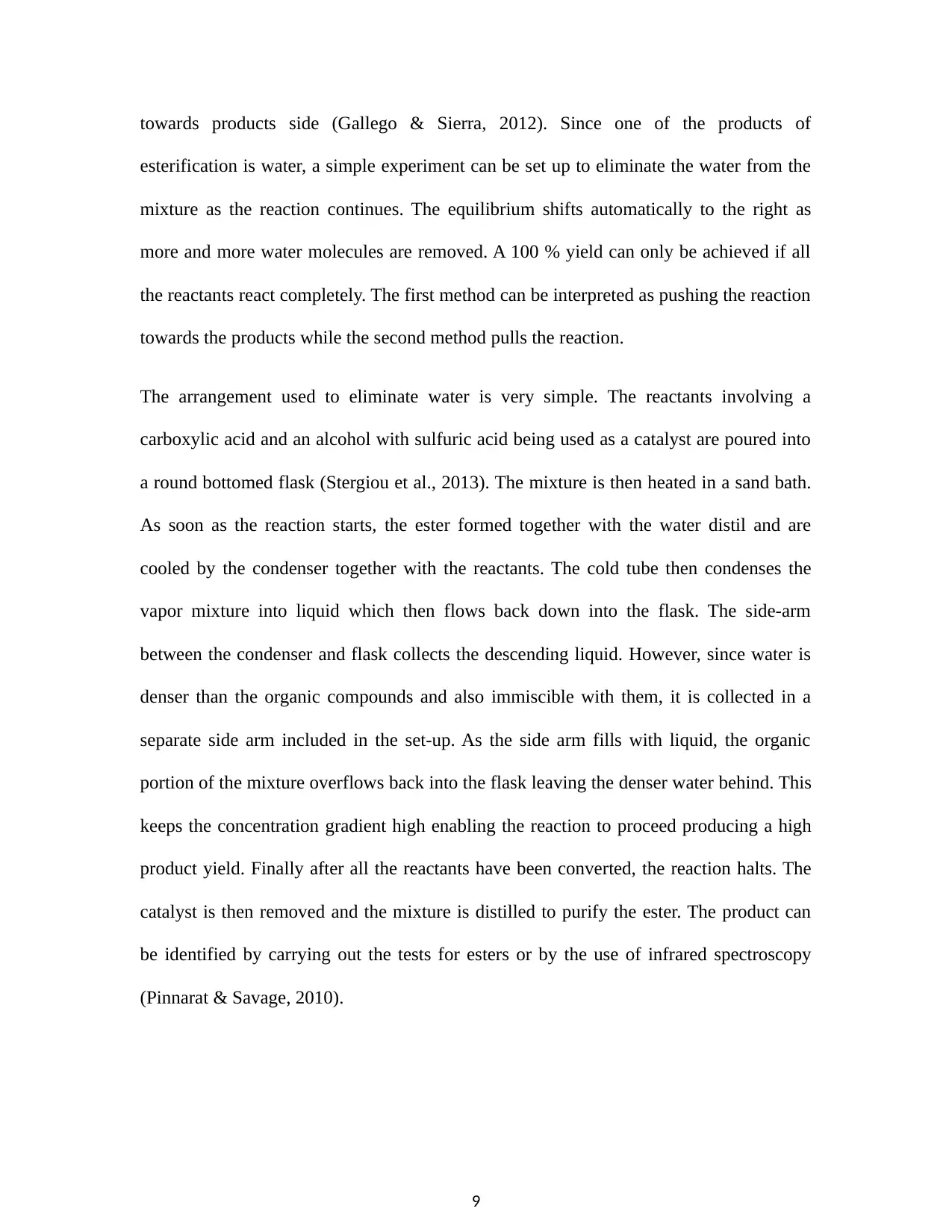
towards products side (Gallego & Sierra, 2012). Since one of the products of
esterification is water, a simple experiment can be set up to eliminate the water from the
mixture as the reaction continues. The equilibrium shifts automatically to the right as
more and more water molecules are removed. A 100 % yield can only be achieved if all
the reactants react completely. The first method can be interpreted as pushing the reaction
towards the products while the second method pulls the reaction.
The arrangement used to eliminate water is very simple. The reactants involving a
carboxylic acid and an alcohol with sulfuric acid being used as a catalyst are poured into
a round bottomed flask (Stergiou et al., 2013). The mixture is then heated in a sand bath.
As soon as the reaction starts, the ester formed together with the water distil and are
cooled by the condenser together with the reactants. The cold tube then condenses the
vapor mixture into liquid which then flows back down into the flask. The side-arm
between the condenser and flask collects the descending liquid. However, since water is
denser than the organic compounds and also immiscible with them, it is collected in a
separate side arm included in the set-up. As the side arm fills with liquid, the organic
portion of the mixture overflows back into the flask leaving the denser water behind. This
keeps the concentration gradient high enabling the reaction to proceed producing a high
product yield. Finally after all the reactants have been converted, the reaction halts. The
catalyst is then removed and the mixture is distilled to purify the ester. The product can
be identified by carrying out the tests for esters or by the use of infrared spectroscopy
(Pinnarat & Savage, 2010).
9
esterification is water, a simple experiment can be set up to eliminate the water from the
mixture as the reaction continues. The equilibrium shifts automatically to the right as
more and more water molecules are removed. A 100 % yield can only be achieved if all
the reactants react completely. The first method can be interpreted as pushing the reaction
towards the products while the second method pulls the reaction.
The arrangement used to eliminate water is very simple. The reactants involving a
carboxylic acid and an alcohol with sulfuric acid being used as a catalyst are poured into
a round bottomed flask (Stergiou et al., 2013). The mixture is then heated in a sand bath.
As soon as the reaction starts, the ester formed together with the water distil and are
cooled by the condenser together with the reactants. The cold tube then condenses the
vapor mixture into liquid which then flows back down into the flask. The side-arm
between the condenser and flask collects the descending liquid. However, since water is
denser than the organic compounds and also immiscible with them, it is collected in a
separate side arm included in the set-up. As the side arm fills with liquid, the organic
portion of the mixture overflows back into the flask leaving the denser water behind. This
keeps the concentration gradient high enabling the reaction to proceed producing a high
product yield. Finally after all the reactants have been converted, the reaction halts. The
catalyst is then removed and the mixture is distilled to purify the ester. The product can
be identified by carrying out the tests for esters or by the use of infrared spectroscopy
(Pinnarat & Savage, 2010).
9
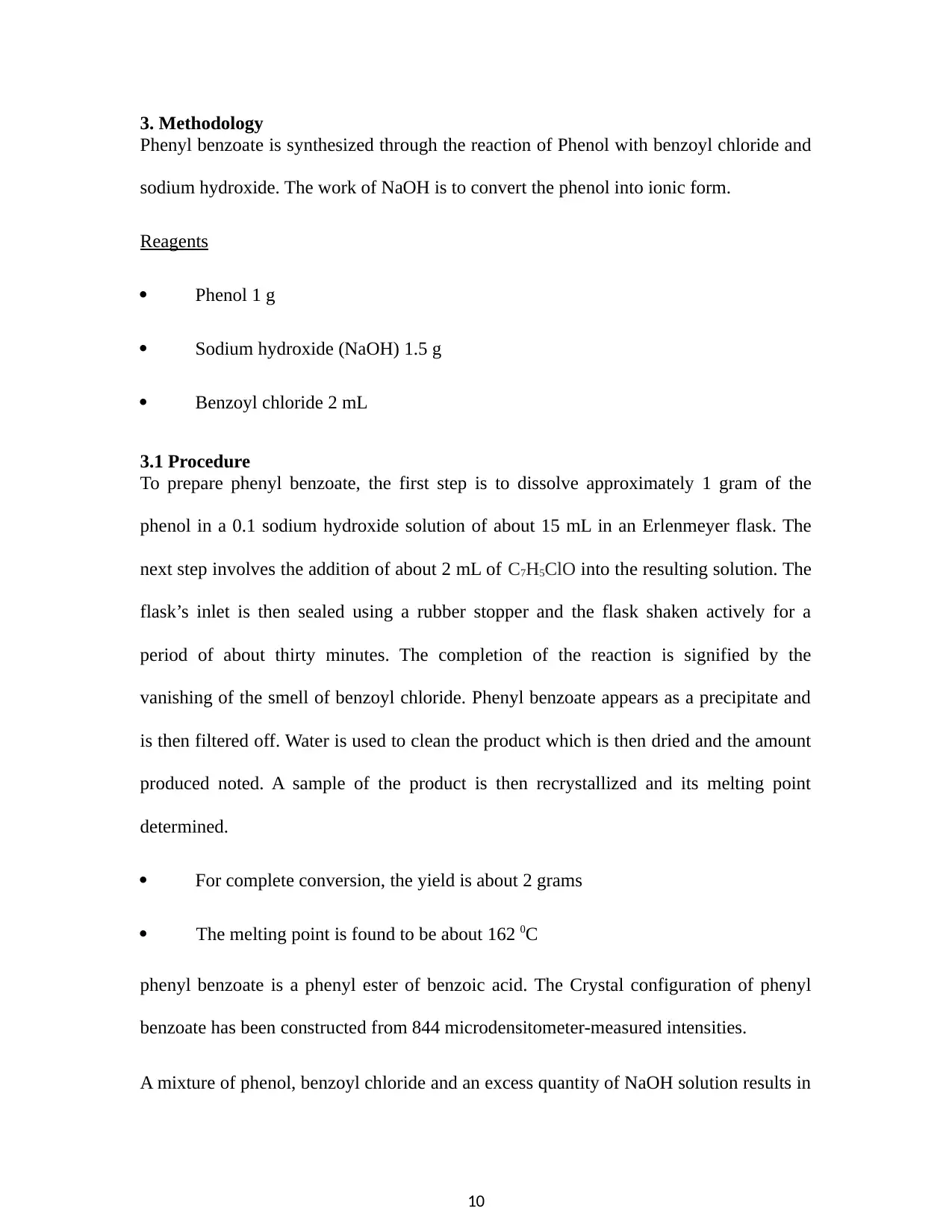
3. Methodology
Phenyl benzoate is synthesized through the reaction of Phenol with benzoyl chloride and
sodium hydroxide. The work of NaOH is to convert the phenol into ionic form.
Reagents
Phenol 1 g
Sodium hydroxide (NaOH) 1.5 g
Benzoyl chloride 2 mL
3.1 Procedure
To prepare phenyl benzoate, the first step is to dissolve approximately 1 gram of the
phenol in a 0.1 sodium hydroxide solution of about 15 mL in an Erlenmeyer flask. The
next step involves the addition of about 2 mL of C7H5ClO into the resulting solution. The
flask’s inlet is then sealed using a rubber stopper and the flask shaken actively for a
period of about thirty minutes. The completion of the reaction is signified by the
vanishing of the smell of benzoyl chloride. Phenyl benzoate appears as a precipitate and
is then filtered off. Water is used to clean the product which is then dried and the amount
produced noted. A sample of the product is then recrystallized and its melting point
determined.
For complete conversion, the yield is about 2 grams
The melting point is found to be about 162 0C
phenyl benzoate is a phenyl ester of benzoic acid. The Crystal configuration of phenyl
benzoate has been constructed from 844 microdensitometer-measured intensities.
A mixture of phenol, benzoyl chloride and an excess quantity of NaOH solution results in
10
Phenyl benzoate is synthesized through the reaction of Phenol with benzoyl chloride and
sodium hydroxide. The work of NaOH is to convert the phenol into ionic form.
Reagents
Phenol 1 g
Sodium hydroxide (NaOH) 1.5 g
Benzoyl chloride 2 mL
3.1 Procedure
To prepare phenyl benzoate, the first step is to dissolve approximately 1 gram of the
phenol in a 0.1 sodium hydroxide solution of about 15 mL in an Erlenmeyer flask. The
next step involves the addition of about 2 mL of C7H5ClO into the resulting solution. The
flask’s inlet is then sealed using a rubber stopper and the flask shaken actively for a
period of about thirty minutes. The completion of the reaction is signified by the
vanishing of the smell of benzoyl chloride. Phenyl benzoate appears as a precipitate and
is then filtered off. Water is used to clean the product which is then dried and the amount
produced noted. A sample of the product is then recrystallized and its melting point
determined.
For complete conversion, the yield is about 2 grams
The melting point is found to be about 162 0C
phenyl benzoate is a phenyl ester of benzoic acid. The Crystal configuration of phenyl
benzoate has been constructed from 844 microdensitometer-measured intensities.
A mixture of phenol, benzoyl chloride and an excess quantity of NaOH solution results in
10
⊘ This is a preview!⊘
Do you want full access?
Subscribe today to unlock all pages.

Trusted by 1+ million students worldwide
1 out of 20
Related Documents
Your All-in-One AI-Powered Toolkit for Academic Success.
+13062052269
info@desklib.com
Available 24*7 on WhatsApp / Email
![[object Object]](/_next/static/media/star-bottom.7253800d.svg)
Unlock your academic potential
Copyright © 2020–2025 A2Z Services. All Rights Reserved. Developed and managed by ZUCOL.





